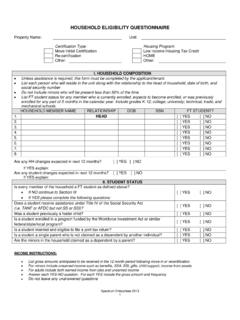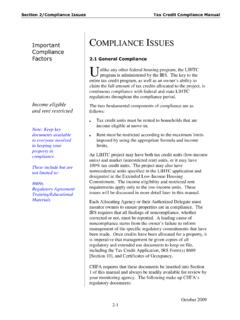Transcription of DETERMINING TENANT ELIGIBILITY
1 Section 3/ DETERMINING TENANT ELIGIBILITY DETERMINING Tax Credit Compliance Manual TENANT ELIGIBILITY for LIHTC Income and student status must be considered Household Size TENANT ELIGIBILITY Overview Owners must determine and document the ELIGIBILITY of potential low-income tenants in accordance with LIHTC requirements . A TENANT s income ELIGIBILITY is determined by comparing the household s gross annual anticipated income per HUD guidelines to the LIHTC 50% or 60% area gross median income limits that apply to the project. As previously mentioned in Section (H) of this manual, student status may also affect the ELIGIBILITY of a household.
2 Owners must verify the household s income and the student status of all household members and the TENANT and owner must certify the accuracy of the verified information. Since household composition, income, and student status may change over time, owners must re-certify the ELIGIBILITY of tenants in tax credit units annually, on or before the anniversary date of the previous certification. Household Size and Income Limits Section 42 mandates that HUD income limits as adjusted for household size be used in DETERMINING income ELIGIBILITY for the LIHTC. A household can consist of one or more persons.
3 Members do not need to be related to be considered a household. Count all household members and compare to the per person 50% or 60% income limits currently in effect. Full- time students residing together in a unit do not constitute a household under LIHTC requirements unless one of the exceptions listed in Section (H) applies. Certain individuals are not considered members of the household in DETERMINING the income limits. Do NOT count the following in DETERMINING income limits: n Live-in Attendants n Visitors or Guests n Foster Children n Foster Adults Temporarily absent members who would be included in the household size determination include: 3-1 October 2009 Section 3/ DETERMINING TENANT ELIGIBILITY Note: Spouses not Tax Credit Compliance Manual currently residing with the applicant but who may return are counted as household members.
4 Separation agreements, estrangement and divorce documents must all be on file to exclude income of spouses that are not expected to become members of the household. Unborn children and children being adopted are counted for income limits Definition of Income n Children temporarily absent due to placement in a foster home n Children away at school, but who live with the family during school recesses n A person confined to a hospital or nursing home per family decision n A son or daughter on active military duty only if this person leaves dependents or a spouse in the unit n CHFA recognizes unborn children and children in the process of being adopted as household members in DETERMINING income limits.
5 Gross Annual Income The codes states TENANT income is calculated in a manner consistent with the DETERMINING of annual income under Section 8 of the United States Housing Act of 1937 ( Section 8 ), not in accordance with the determination of gross income for federal income tax liability. In the HUD Handbook REV-1, 5-3 annual income is defined as the anticipated total income from all sources received by the family head and spouse (even if temporarily absent) and by each additional member of the family, including all net income derived from assets for the 12-month period following the effective date of certification of income, exclusive of certain types of income.
6 3-2 October 2009 Section 3/ DETERMINING TENANT ELIGIBILITY Tax Credit Compliance Manual Total Income from all Sources = Annual Income Gross Earned/ Unearned Income + Net Income from Assets = Annual Income Net Asset Income Cash value of assets and asset income must be verified for entire household If net assets >$5,000 use the greater of actual income or imputed income If net assets < $5,000 Management may use the Under $5,000 Asset Form. Assets disposed of for less than fair market value must be considered assets for two years. For information regarding what annual income includes/excludes and how to calculate annual income, see Section 23 for excerpts from HUD Handbook REV-1, Change 2, 5-6.
7 Note that LIHTC total income is gross annual income, not adjusted annual income. Allowances used in some government programs, such as childcare allowance and medical expense allowance, are not deducted from the household s annual gross income to determine income ELIGIBILITY for LIHTC units. Assets The net income from assets must be considered when DETERMINING the tax ELIGIBILITY of a household. Asset information for all household members (including minors) should be obtained at the time of application. Information regarding what net family assets include/exclude is provided in [Section 23] excerpts from HUD Handbook REV-1, Change 2, 5-83, Exhibit 5-2.
8 The cash value for all assets and asset income must be verified by the owner obtaining third party documentation as specified by HUD verification procedures. Owners may use the sworn statement for assets referenced under IRS Revenue Procedure 94-65 [Section 17]. Assets must be verified for the initial certification of the household and for each recertification. If utilizing the procedure 94-65, please be aware that the income from the asset must always be identified and included as income on the certification. If net family assets exceed $5,000, the asset income to be included in household income will be the greater of: (a) the actual asset income, or (b) an imputed income from assets, which is the net family assets multiplied by the passbook rate specified by HUD.
9 Until further notice, owners must use a rate of 2 percent (.02). At each certification and annual certification, applicants and tenants must declare whether or not an asset has been disposed of 3-3 October 2009 Section 3/ DETERMINING TENANT ELIGIBILITY Tax Credit Compliance Manual Application Procedure Interview Checklist for less than fair market value during the two years preceding the date of application or the effective date of the recertification. An asset is considered to be disposed of for less than fair market value if the cash value of the disposed asset exceeds the gross amount the family received by more than $1,000.
10 If it does, for a period of two years owners must include in the total household assets the difference between the cash value of the asset and the amount received. See [Section 23] HUD Handbook excerpts 5- 33 for examples of assets disposed of for less than fair market value. TENANT Application Procedure Because the LIHTC program uses special definitions for income, assets, and household composition, standard property management application forms may not collect sufficient information to determine TENANT ELIGIBILITY . A comprehensive housing application is critical to the accurate identification of full-time student status, all assets, and anticipated income sources to be verified in the determination of TENANT ELIGIBILITY for the LIHTC.


